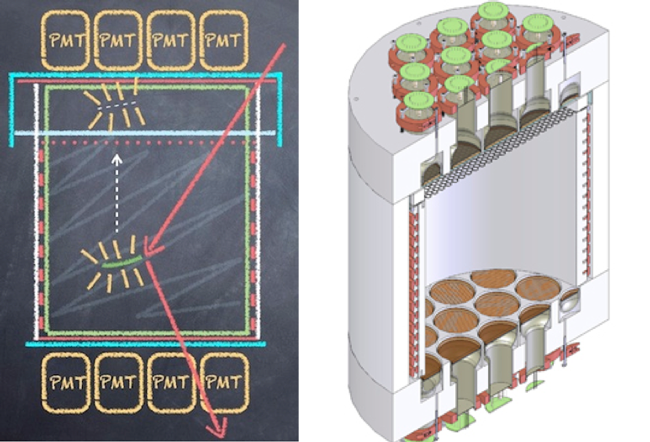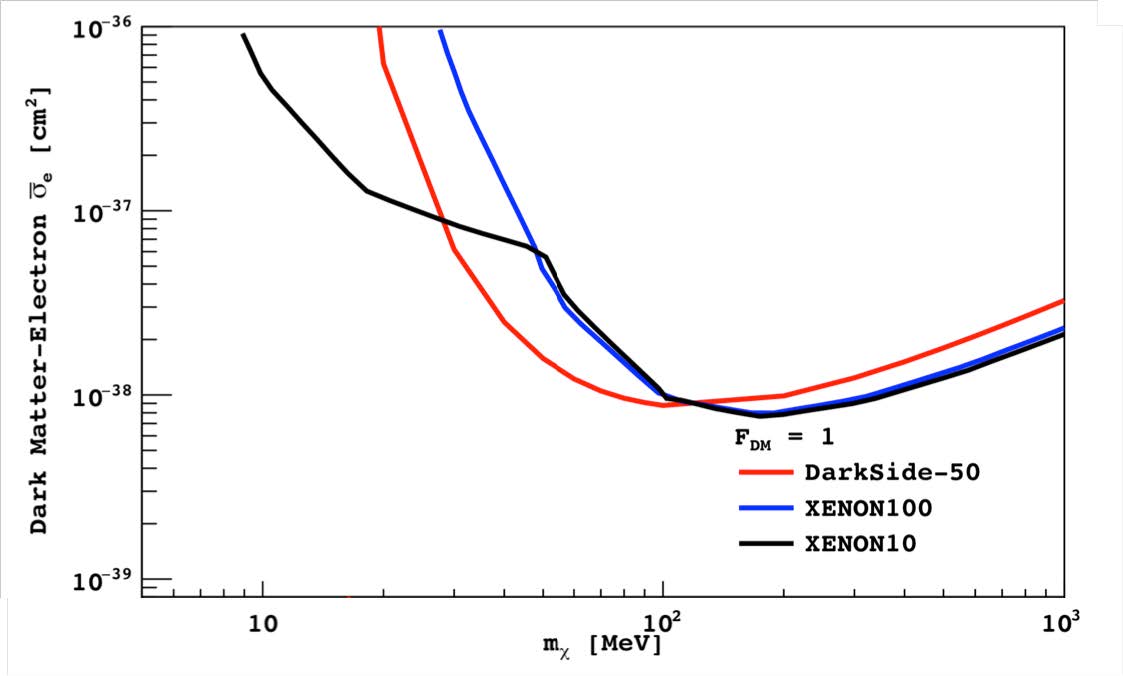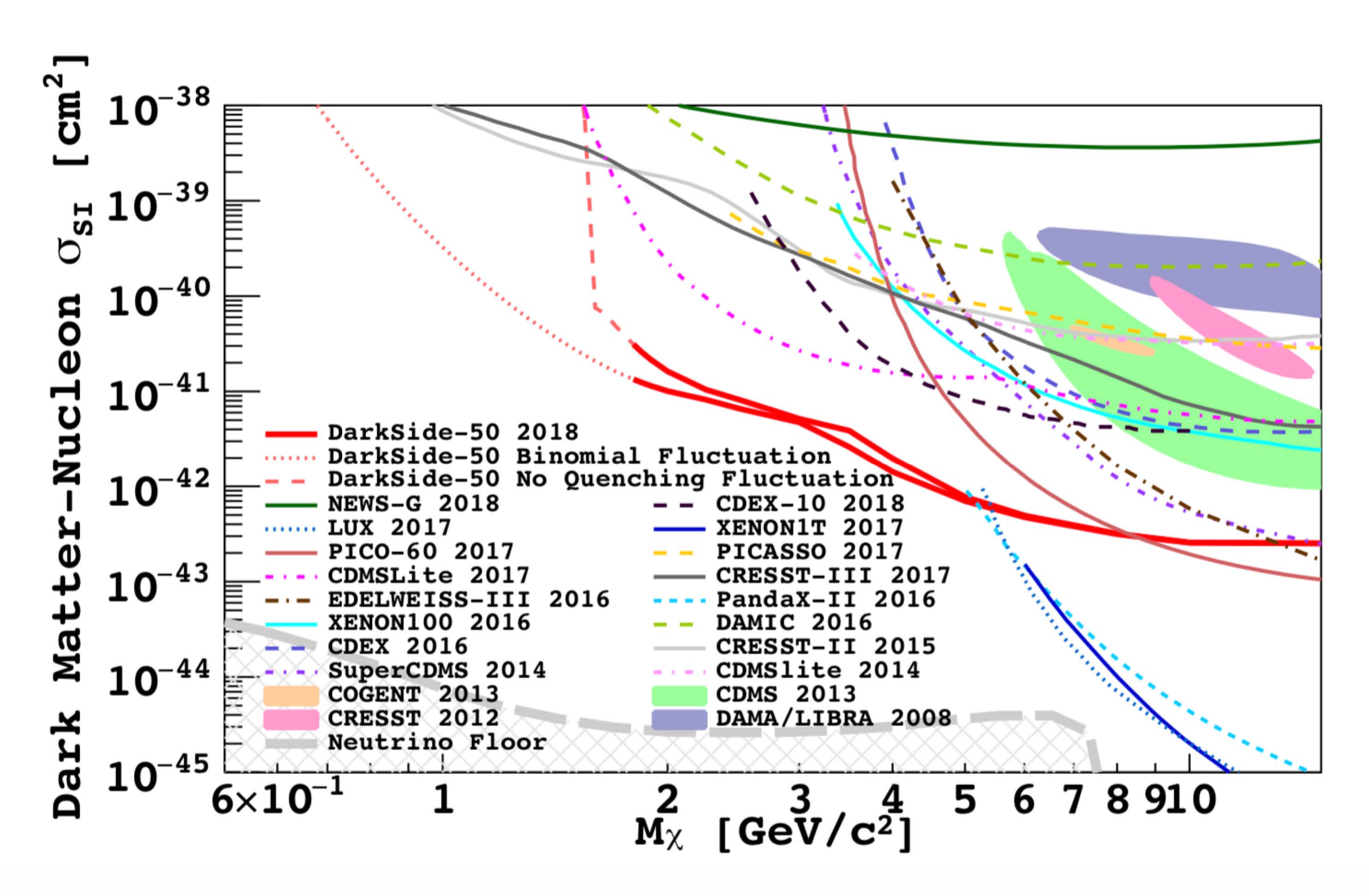JE2: Direct Dark Matter Search
> Read the articles connected to the project.
-
In the last two decades, cosmological data from observations of the cosmic microwave background fluctuations, large-scale galaxy surveys, studies of large scale structure formation and of the dynamics of galaxy clusters, have all provided a wide range of astronomical evidences of the existence of gravitational effects, not arising from normal matter. The source of this deep mystery is a non-ordinary matter, called “dark” because it is invisible. Understanding the “dark matter”, which constitutes about 1/4 of our Universe, is one of the most important challenges in modern cosmology.
One possibility, motivated by considerations in elementary particle physics, is that dark matter consists of undiscovered elementary particles. A leading candidate explanation is that Dark Matter is composed of Weakly Interacting Massive Particle (WIMP) formed in the early universe and gravitationally clustered together with the standard baryonic matter.
Several terrestrial experiments are searching for WIMP collisions with ordinary nuclei, whose recoils could in principle be observed at low energies (< 100 keV). The very low interaction rates expected in this kind of research push the experiments to explore new avenues to increase the sensitivity to the WIMPs trough their scattering with target nuclei.
Liquid argon based detectors offers at the same time the advantage of a target scalable to multi-ton masses, and the unique add-on key feature of the excellent pulse shape discrimination power to disentangle WIMP signal from electron-like background.
In particular, two-phase liquid argon time projection chambers (LAr TPCs), which detect scintillation light and ionization generated by recoiling nuclei, are particularly promising since they guarantee a high accuracy for determining 3-D event positions.
The DarkSide Program
DarkSide is a multi-staged program for developing two-phase LAr TPCs using several innovative techniques to positively identify Dark Matter signals and to understand and suppress background. DarkSide-50 has already demonstrated the exceptional LAr discrimination power (>107) for rejecting electron-like background, the low 39Ar contamination in LAr extracted from deep underground, and the high efficiency of an active neutron veto to strongly suppress neutron background. The DarkSide program is intended to progress to multi-ton detectors with high sensitivity for WIMP detection.
The LabEx UnivEarthS JE2 team works on the data analysis of DarkSide-50, leading all the simulation activities.
The DarkSide-20k Technological Challenge
The next DarkSide phase will use 20-ton fiducial mass liquid argon as target for searching for WIMP interactions. To improve the sensitivity and reduce the background, the detector will be equipped with a new class of photo-sensors, the Silicon Pohotomultiplier (SiPMs) arrays, replacing the standard Photomultiplier Tubes (PMTs).
The SiPMs are arrays of Silicon based avalanche photodiodes (APD). The dimension of each single APD can vary from 20 to 100 μm, and their density can be up to 1000 mm-2. The capability of SiPM to clearly identify single photoelectrons allows studying in great detail the scintillation of liquid argon at low energies, a key element for the correct interpretation of data from the DarkSide detector.
SiPMs provide also direct advantages when compared to the standard PMTs. The dark noise, in fact, strongly suppressed for the SiPMs at the liquid argon temperature, can be lower than for the standard PMTs. Further, the amount of material used for the SiPM, considerably lower than for standard PMTs, and the radio-purity of the SiPM materials, allow to reduce the neutron contamination from (alpha,n) reactions, the most dangerous background in DarkSide. The limited sizes of the SiPMs allow, also, to increase the liquid argon active mass in the TPC, enhancing the sensitivity to the direct dark matter detection.
The LabEx UnivEarthS JE2 team will characterize the behavior of SiPMs (and of their associated electronics) in a liquid argon environment.
-
POSITION NAME SURNAME LABORATORY NAME GRADE, EMPLOYER WP leader Davide Franco APC CR1/ CNRS WP member Alessandra Tonazzo APC Professor, Université Paris-Diderot WP member Michela Lai APC/Cagliari U. PhD, Université Paris-Diderot / Cagliari
U.WP member Paolo Agnes Houston U. / APC Post-doc, associated at APC -
To go further, you can visit these pages :
Official DarkSide webpage: http://darkside.lngs.infn.it/
Aris Project webpage : http://aris.in2p3.fr/
The LabEx JE2 program was developed to characterize liquid argon (LAr) response to electron and nuclear recoils, in the energy range of interest for the direct dark matter search. LAr scintillation, ionization, and ion-electron recombination effects are, in fact, poorly modeled and represent the main sources of systematics in dark matter experiments. LAr scintillation yield depends on a double mechanism: the direct excitation of argon molecules, and the recombination between electrons and ions, after the ionization of argon. Both the processes lead to an excited state of the argon molecule. The interacting particle recoil energy is then estimated by counting, with photomultiplier tubes, the overall emitted photons, following the argon de-excitation. The WIMP signal is expectedresponse, and where calibrations with radioactive sources are extremely challenging. The most accredited scintillation models are the Thomas–Imel and the Doke’s modified Birks’ law. Both of them are based on the same ion-electron recombination physics, albeit with different descriptions governed by short– or long–track limits.
Unfortunately, none of them, alone, is able to predict the primary scintillation efficiency at low energies in LAr. A model able to accurately describe scintillation, ionization, and recombination effects in LAr, in presence of electric fields, is of great impact of the dark matter search, by boosting the sensitivity and improving future detector designs.The LabEx JE2 program was developed on two main branches: (1) the LAr response model based on the DarkSide-50 data; (2) measurement of LAr properties with a small-scale TPC exposed to neutron/gamma beams. Thanks to the accomplishments of both items (1) and (2), the JE2 team has played a leading role in (3) the analysis of very-low energy events in DS-50, characterized by the presence of the sole ionization events, which has led to the world-best limit to WIMPs with masses below 6 GeV/c2 (PRL 121 (2018) 081307), extended by more than a factor 10 with respect to previous limits, and to WIMP-electron interactions (PRL 121 (2018) 111303) assuming heavy mediator with DarkSide-50 data. It is worth to stress that such result represents a revolutionary milestone in the field, since it
breaks the generally recognized paradigm, for which noble liquid experiments were competitive only above 10 GeV/c2, and solid-state ones at the GeV/c2 scale.(1) Within the DarkSide program, we have entirely developed the full Monte Carlo package, G4DS, which embeds a rich set of particle generators, detailed geometry descriptions, properly tuned physical processes, and the full optical propagation of photons produced by scintillation in liquid argon and electroluminescence in gaseous argon. It tracks all the generated photons until they reach the active region of the photo-sensors, where they are converted, after stochastically surviving a quantum efficiency cut, into photoelectrons.
The core of G4DS is the new LAr response model, named PARIS (Precision Argon Response Ionization and Scintillation). The essence of the PARIS approach is an empirical parametrization of the recombination probability, which depends on the kinetic energy of the ionizing particle. The model is able to reproduce data at a few percent accuracy in both energy scale and detector resolution, without any additional artificial smearing, confirming that we are mastering the correct statistics governing the LAr photon emission. More details can be found in reference: Agnes et al., JINST 12 (2017) P10015. G4DS had and has a great impact on the DarkSide program. Thanks to it, the DarkSide APC team has achieved fundamental milestones. Among them it is worth to mention the measurement of
the extremely low concentration of cosmogenic 39Ar (~0.7 mBq/kg) in argon extracted from deep underground. This result is paving the way toward the future giant LAr detectors: DarkSide-20k, with 20 ton fiducial mass, and the ultimate 300 ton detector, GADMC, able to reach a sensitivity below the so-called “Neutrino-Floor”. As leader of the
“Science, Simulation, and Computing” package of the DarkSide WBS, we are currently heavy employed in the DarkSide-20k design (EPJ Plus 133 (2018) 131).(2) The ARIS experiment (Argon Response Ionization and Scintillation), funded by LabEx JE2, is a small scale TPC exposed to the LICORNE neutron source at the ALTO facility (IPNO). LICORNE produces a highly collimated, pulsed, and quasi-monoenergetic beam thanks to 14.6 MeV 7Li ion interactions on a pure target of Hydrogen. At the same time, 478 keV gammas are emitted by the de-excitation of 7Li, occasionally excited when interacting with the target walls. The beam thus guarantees a double signature: nuclear and electronic recoils from neutrons and Compton electrons, perfectly disentangled thanks to the time-of-flight (TOF) technique. Eight scintillator detectors, opportunely placed around the TPC, detect scattered neutrons and gammas, allowing for the kinematical
reconstruction of the recoil energy in the LAr target. The large statistics obtained during the 12 days of beam time, in addition to the exceptional time and (~1.5 ns) energy (~6% at 60 keV) resolutions, are the main keys at the basis of the success of ARIS, currently the most accurate experiment in characterizing noble liquids for dark matter search and at the lowest energy. Beyond this result, ARIS is the first experiment able to observe single Compton electrons, providing the most stringent test (1.6%) of the linearity of the energy response to electronic recoils at field-off. ARIS has also measured a dependence of the LAr time response on the electric field, totally unexpected and never observed before. Finally, the PARIS model, developed for DarkSide-50 at 200 V/cm, is in excellent agreement with
ARIS data at the same field. The first ARIS paper has been recently published (PRD 97 (2018) 11 112005), and the second on the LAr time response is in preparation.(3) The low-mass WIMP analysis, previously mentioned, is the byproduct of a close collaboration between APC, LPNHE, Princeton, and Sao Paolo University (USP). Thanks to the large amplification factor (~23 photoelectrons/electron) of the ionization signal, DarkSide-50 data has been explored down to 4 ionization electrons, corresponding to 100 eVee. We have demonstrated that the trigger efficiency is 100% already at 1.3 electrons (~30 photoelectrons). The smoking gun, demonstrating the exceptional comprehension of such a low energy region, is provided by 37Ar (τ ~50 days), a cosmogenic isotope, naturally present in first 100 days of exposure. By comparing the first 100 days of data with the remaining 500 days, we’ve observed the two 37Ar gamma lines at 270 eV and 2.8 keV. The ratio between the two detected peaks corresponds to the expected 37Ar branching ratio. Despite the very accurate determination of the electronic recoil energy scale granted by 37Ar, the analysis can not be performed without the calibration of the ionization yield for nuclear recoils, the signal expected from WIMPs, which suffers from the
quenching effect. ARIS results have played a crucial role, representing a perfect calibration candle down to ~7 keVnr.
However, in order to reach the analysis threshold of 0.6 keVnr (or 100 eVee), the JE2 team has re-analyzed calibration data taken with AmBe (above plot on the right) and AmC neutron sources, deployed in the scintillator veto, outside the DarkSide-50 cryostat. Neutrons, in fact, induce nuclear recoils identical to signal ones. Thanks to our fitting procedure based on G4DS spectra, we have been able to provide the calibration of nuclear recoil ionization yield down to 4 electrons, which resulted in good agreement with ARIS data at higher energies.Thanks to such calibrations, we have been able to extend previous exclusion limits on WIMPs with masses between 1.8 and 6 GeV/c2 by about an order of magnitude (left plot). The lower threshold at 1.8 GeV/c2 is imposed by the lack of knowledge on the statistics governing nuclear recoil quenching fluctuations: assuming it in the standard hypothesis of binomial statistics, our analysis shows the potential in excluding WIMP with masses down to 0.6 GeV/c2 (dashed red line in the left plot). Swapping the signal model with the one induced by WIMP-electron interactions, we have also extended previous limits assuming a heavy mediator, as shown in the right plot.
-
Official DarkSide webpage: http://darkside.lngs.infn.it/
D. Franco, 2018
New Physics Results from DarkSide-50,
Proceeding of 53rd Rencontres de Moriond on Electroweak Interactions and Unified TheoriesDarkSide Collaboration,
Low-mass Dark Matter Search with the DarkSide-50 Experiment
Phys. Rev. Lett. 121 (2018) 081307DarkSide Collaboration,
Constraints on Sub-GeV Dark Matter-Electron Scattering from the DarkSide-50 Experiment
arXiv:1802.06998 (2018) (accepted by PRL)DarkSide Collaboration,
DarkSide-50 532-day Dark Matter Search with Low-Radioactivity Argon
arXiv:1802.07198 (2018)DarkSide Collaboration,
Electroluminescence pulse shape and electron diffusion in liquid argon measured in a dual-phase TPC
arXiv:1802.01427 (2018)P. Agnes et al. (ARIS Collaboration)
Measurement of the liquid argon energy response to nuclear and electronic recoils
Phys. Rev. D97 (2018) 11 112005DarkSide Collaboration
The Electronics, Trigger and Data Acquisition System for the Liquid Argon Time Projection Chamber of the DarkSide-50 Search for Dark Matter
Journal of Instrumentation Dec. 2017, vol.12, no.12, P12011 (23 pp.). DOI: 10.1088/1748-0221/12/12/P12011DarkSide Collaboration,
DarkSide-20k: A 20 Tonne Two-Phase LAr TPC for Direct Dark Matter Detection at LNGS
2017, arXiv:1707.08145, submitted to Physics Letters BDarkSide Collaboration
Simulation of argon response and light detection in the DarkSide-50 dual phase TPC,
october 2017, JINST, arXiv:1707.05630D. Franco and N. Saviano,
Particle Physics in the Cosmos
Proceeding of Science NOW2016 (2017) 095DarkSide Collaboration,
CALIS – a CALibration Insertion System for the DarkSide-50 dark matter search experiment
Journal of Instrumentation Dec. 2017, vol.12, no.12, T12004 (19 pp.). ISSN: 1748-0221 (print), Publisher: IOP Publishing Country of Publication: UK DOI: 10.1088/1748-0221/12/12/T12004DarkSide Collaboration,
Effect of Low Electric Fields on Alpha Scintillation Light Yield in Liquid Argon
2017 JINST 12 P01021 DOI: 10.1088/1748-0221/12/01/P01021DarkSide Collaboration,
DarkSide-20k: A 20 Tonne Two-Phase LAr TPC for Direct Dark Matter Detection at LNGS
arXiv:1707.08145 (2017)
[/restabs]





